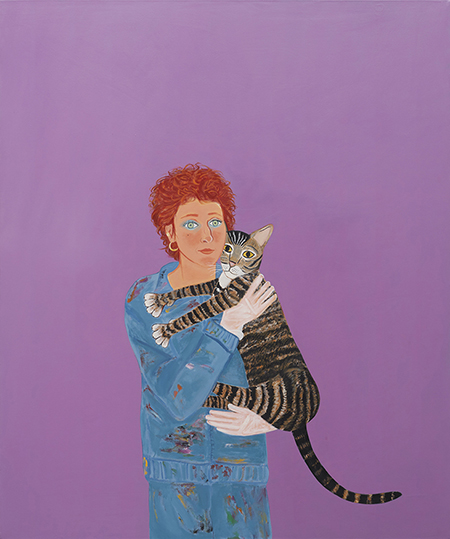
Continuing through April 6, 2024
In my recent review of paintings by Hung Viet Nguyen, I noted that spirituality in contemporary art has deep roots in Southern California, but I neglected to mention that there were also a number of Bay Area artists who sought to reconcile their spiritual inclinations with contemporary life. As this exhibition of ten stellar paintings created between 1972 and 1983 reveals, Joan Brown (1938-1990) was one of them. Although in her early work she followed practices of Abstract Expressionism and the Bay Area Figurative School, painting everyday subjects using thick gestural brushwork, she was also hanging out with the Beat artists with whom she exhibited at the Six Gallery. It was here that Allen Ginsberg gave his legendary reading of “Howl” and declared “Everything is holy!”
As time went on, Brown became interested in mysticism and the spiritual traditions of different cultures. She journeyed across the globe to learn more about them. In 1977 she traveled to Egypt, where she visited historical sites and was deeply affected by what she termed the “lavender” color of the region’s light. In 1980, she married her fourth husband Michael Hebel, who was on a similar spiritual path. Together, they traveled frequently to India, where they studied Hinduism with guru Sathya Sai Baba.
Prior to her Egyptian excursion, Brown had already reduced the density of her paint in order to lend clarity to her subject matter. At the same time, she began emphasizing iconography over style. In “Noel at His Desk with Mickey the Cat” (1972), her ten-year-old son is shown seated at a desk, looking at the viewer with pencil in hand. Rather than illuminate what he is writing, the light from the desk lamp shines directly on Noel, as he is the object of the artist’s love and affection. To pay homage to her swim coach in “Charlie Sava + Friends (Rembrandt + Goya)” (1973), she depicts her honoree flanked by two of her other heroes, old master artists who appear in a darkness bathed in a faint golden light that references their styles. Additionally, she incorporates two references to herself, seen in the background as a barely visible swimmer and in the lower foreground as a statue atop a pedestal, shown poised to dive into a swim.
Self-portraiture, in fact, can be found in several other examples on view. Just as Rembrandt frequently painted his own image, so did Brown. She found the practice helpful in understanding her place in the universe from both material and spiritual perspectives. The former viewpoint is apparent in “Parts of a Woman (After the Operation / A Woman’s Head / The Crystal Beads / The Friendship Ring / The Cat’s Eye Ring / Etta’s Bracelet / Red Patent Leather Shoes)” (1972), a multi-panel painting based on Rene Magritte’s “The Eternally Obvious” (1930), where she examines fragments of her nude body, along with her shoes and jewelry, using slightly vigorous brushstrokes to capture the physicality of flesh. This was the same year Eleanor Antin, in “Carving: A Traditional Sculpture” (1973), documented her weight loss through photographs of her nude body taken daily over several weeks.
Brown turned to exploring her mystical leanings in “The End of the Affair” (1977), where we can observe a sharp division between the material world, represented at left in the form of a presumed former lover seen from behind looking into a mirror, and a spiritualized environment defined by radiant light, where the artist sits gazing at a godlike figure tattooed with Egyptian symbols that also appear next to her on a rug.
One of Brown’s attractions to Egyptian symbolism was the ancient culture’s attribution of divine powers to cats, as deities were often portrayed as sculptures with cat heads. A lover of domestic felines, Brown recognized that the cat figured prominently in her relationship with both the physical and the metaphysical worlds. She celebrated this idea with great finesse in “Accepting the ‘Key of Life’ / The Initiation” (1978), where a cat hands her an ankh symbol, the Egyptian hieroglyph for life and death that is often associated with power, wisdom and higher knowledge, as both artist and animal stand in a luminous field of energy. Lest we not get the point, she depicts herself wearing a dress with a pattern of keys.
In the mid-1980s, while I was Director of Exhibitions at the San Francisco Art Institute, I invited Brown to participate on a panel on “Symbolism in Contemporary Art.” I asked her what advice she would give to others for a fruitful life journey, to which she responded, “No excess baggage.” Indeed, in the two latest paintings here, we can see how she applied this philosophy to her art. “Joan + Donald” (1982) is a straightforward, even minimal portrait of the artist holding her cat. While the artist references the material world through paint smudges depicted on her clothing, she and her pet are bonded in spiritual consciousness through the crystalline glistening of their eyes and the unnatural monochromatic background, which is lavender, the color she designated for Egyptian light. Similarly, “Year of the Tiger” (1983) is presented with simplicity and precision, using a personal hieroglyphics. Here Brown shows herself wearing her painting clothes, flanked by two cats and surrounded by astrological symbols. Cleverly, her paintbrush is positioned as if she has just painted an athletically limber female Egyptian who likely represents her spiritual self or her persona from a previous life, as she believed in reincarnation. At a time when spiritual content was often frowned upon as a direction for contemporary artists, Brown was unabashedly proud of having embraced it, in art as in life.
